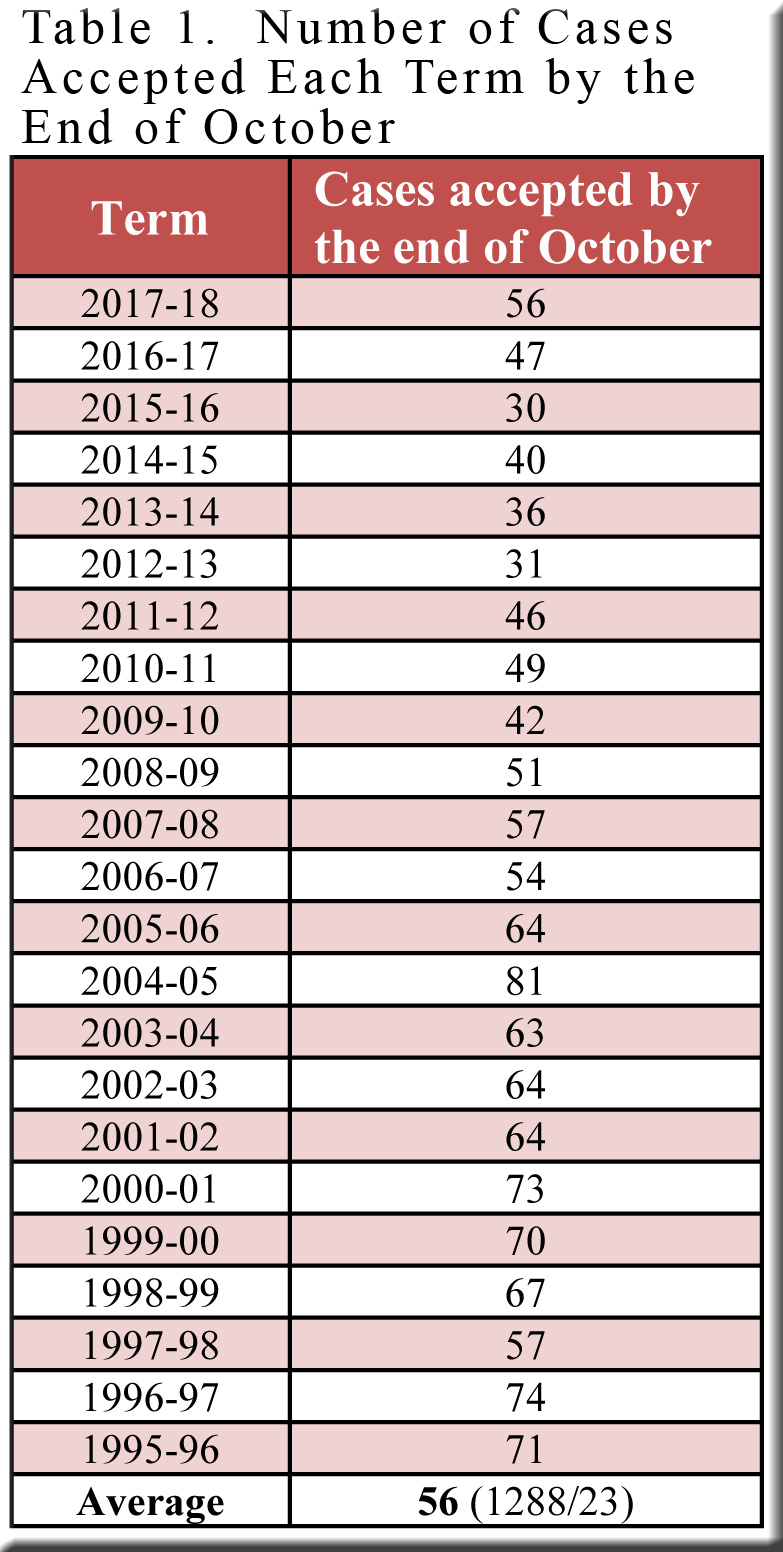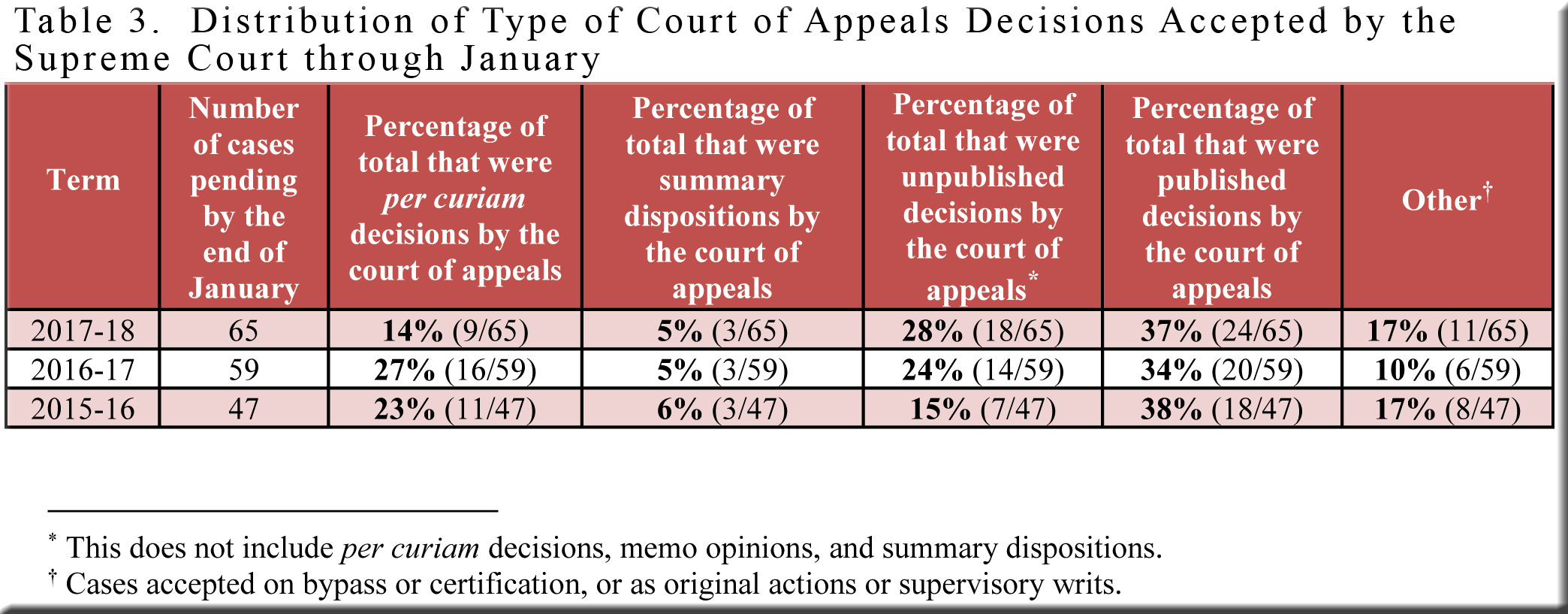As the court enters a six-month stretch during which the large majority of the year’s decisions will be filed, a SCOWstats reader has asked how things stand regarding the number of cases likely to be decided by the end of the 2017-18 term. We have been offering such predictions at roughly this time of year ever since Justice Abrahamson voiced concern on the subject in the autumn of 2015, and this post amounts to a continuation of that practice by responding to the reader’s question.[1]
Number of Decisions
The issue arose as a result of the historically low number of decisions filed by the court in recent years—most notably, 46 decisions in 2012-13, 43 in 2015-16, and 51 in 2016-17. As early as last October, it appeared that the justices were determined to do better in 2017-18, for they had already accepted 56 cases by the end of that month—a total that had not been matched for a decade, as evident in Table 1.
(click on tables to enlarge them)
Three months later, in January 2018, the court’s total of accepted cases has risen to 65, continuing to outstrip the corresponding sums from the two preceding years.[2] At this point in the term, it should be possible to estimate the number of cases that will be decided by summer’s end, based on the justices’ track record over the two previous years. More specifically, in each of the past two terms, no more than half the cases accepted for review in January were decided by the end of the same term, and none of the cases accepted in February reached a decision before the following term (Table 2). Thus, it appears reasonable to suppose that all of the decisions filed in 2017-18 will come from the 65 cases already on the court’s docket.[3] Any cases accepted in February or subsequent months will likely have to await decisions in the 2018-19 term.
Four of the current batch of 65 cases were accepted in January, and the information in Table 2 suggests that two of them may not receive decisions by term’s end. It’s possible, of course, that the justices will surpass the pace of recent years to such an extent that all four of these January cases will be decided by this summer—though we may also find that a case accepted earlier in the term encounters various delays sufficient to postpone its decision until the ensuing term. This occurred with Seifert v. Balink, for example, which was accepted for review in November of the 2015-16 term, but not decided until January of 2017, and with Springer v. Nohl Electric (accepted in October of 2016 and still without a decision).
Taking all of this into consideration, the yield of decisions for 2017-18 should reach the low 60s, and, if pressed for a more precise estimate, I’d settle on 63. Although 63 cases amount to only half the annual volume handled by the court in the early 1980s (and well below the 92 decisions filed just 15 years ago), it is also the highest total since 2007-08, when 70 decisions were issued. By the standard of recent years, then, 63 decisions would represent an abundant harvest.
Per Curiam Decisions
In addition to her apprehension over the size of the court’s caseload, Justice Abrahamson also worried about its content—in particular, the swelling portion of cases that reached the supreme court as per curiam decisions from the court of appeals. Until recently, these cases had never constituted more than 15% (and often less than 10%) of the court’s docket, but that changed dramatically in 2015-16. As shown in Table 3, per curiam decisions from the court of appeals accounted for 23% of the cases accepted by the supreme court through January of 2016, and that figure rose to 27% a year later. If, as Justice Abrahamson warned, per curiam cases “do not involve ‘new or unsettled questions of general importance,’” their growing prominence in the supreme court’s docket was indeed troubling.
For anyone concerned about this “trend,” the data for 2017-18 will be reassuring, as only 14% of the 65 cases accepted for review through January arrived before the justices as per curiam decisions. This sharp drop has been balanced by smaller increases in other types of court of appeals decisions as well as cases accepted on bypass or certification (Table 3).
Conclusion
Compared to data from the past few years, the numbers for 2017-18 are promising for both the issues at hand. The quantity of decisions filed by the end of this term is likely to hit a ten-year high, while the justices’ per curiam dosage is only half that of 2016-17. As explained above, estimates formulated in January have proved to be accurate predictions of a term’s final results, so these conclusions are apt to stand. Whether they herald anything beyond 2018 is much less clear, given the statistics’ volatility of late. But, in view of recent trends regarding the topics before us, even an uncertain reversal of course is an encouraging outcome.
[1] Click here for Justice Abrahamson’s misgivings.
[2] The total of 65 includes the four cases accepted during the court’s only petitions conference scheduled for the month of January. Through January of the 2016-17 term, the court had accepted 59 cases for review, and 47 cases through January of 2015-16.
[3] As of January 10, 2018, 8 cases had already been decided; 28 were awaiting decisions; 15 were awaiting oral argument; and 14 were in various stages of briefing.



Speak Your Mind